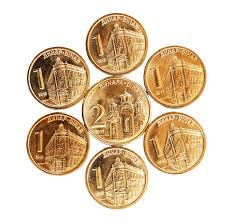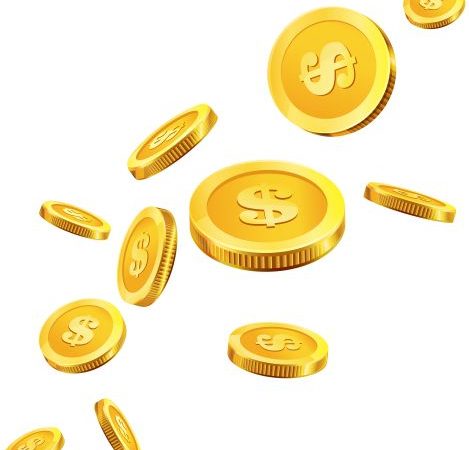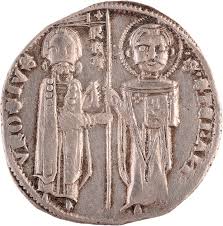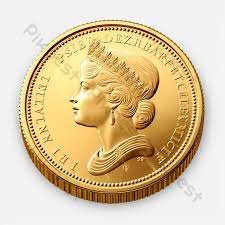She is familiar to us from the gypsy motifs of Goran Bregovic’s music and the reckless fun of Emir Kusturica’s films. Particularly indicative in this regard is the “Underground”. Serbia, just like after the Second World War, is getting up from its knees after the NATO bombings, licking its wounds, trying to live without Kosovo and Montenegro. The people here are smiling and cheerful.
And even though almost no one has the desired wealth, they are rich in soul, love of life, the ability to enjoy life, accepting it as it is. The coins of modern Serbia reveal to us the religious and cultural side of this region and proudly display portraits of the great Serbs Mikhail Pupin, Nikola Tesla and other scientists, writers, and patrons.
Coins of a modern design, which are still in circulation today, first appeared on July 2, 2003, when the Yugoslav dinar was officially replaced by the Serbian one. The diameter of the coins increases as the denomination increases: from 20 mm (1 dinar) to 28 mm (20 dinars). The first issues were minted from copper-nickel and copper-zinc alloys. Since 2009, 1 and 2 dinars have a steel base, which is coated with brass. Since 2013, the 5 dinars also have a steel base.
and the electroplating of this trio of coins becomes two-layer: first, a thin layer of copper is applied to the low-carbon steel core, and brass is applied to it. The National Bank of Serbia indicates that state symbols and an indication of the issuer are located on the reverse of each of the coins. The obverse is occupied by the denomination, the year of issue, as well as the image of an object of historical and cultural heritage.
Mostly these are Serbian Orthodox monasteries and churches of the 12th-17th centuries. Historically, the Christian faith came to Serbia early. In 879, the Serbs converted to Orthodoxy, and in 969 the country separated from Byzantium, asserting its independence. The heyday of the Serbian kingdom fell on the 13th century, it was at this time that the active construction of monasteries and temples began. We see them on everyday coins of the country. Distinguished by their unique architectural style, richness of frescoes and icons, they are the visiting card of the country.
Medieval Serbian monasteries
The 2 dinar coin features the Gracanica Monastery, the “Serbian pearl”, located in the central part of Kosovo. Currently, this is a functioning convent, which is under the protection of UNESCO. On the obverse of the mentioned coin we see an image of the main building of the monastery – the five-domed Assumption Cathedral (1315-1321 years of construction).
famous for its frescoes with the Great Feasts, the suffering of Christ, miracles, the composition of the Last Judgment, as well as portraits of Serbian rulers in monastic attire (among them the king Milutin with his wife Simonida Paleolog). The 14th and 15th centuries are considered the best period in the history of the monastery. Gracanitsa prospered: the brethren led an active spiritual life, developed crafts and book writing (ten handwritten books of that time have survived to this day).
Serbia, set of coins 1, 2 and 5 dinars 2013
Another old Serbian monastery – Krushedol can be seen on the reverse of the 5 dinars coin. Krushedol is located on Fruska Gora, also called “Serbian Athos”, where most of all Serbian monasteries are concentrated. An architectural monument of the 16th century.
Krushedol was erected by Bishop Maksim and his mother Angelina, the wife of the last king of the Branković dynasty, later canonized by the Serbian Orthodox Church. Krushedol is famous for its 15th-century iconostasis of 36 icons made in the style of Byzantine iconography. In addition, in Krushedol there is a tomb of historical figures of Serbia: patriarchs and kings. Currently, Krushedol is also an active convent.
The coin of 10 dinars is decorated with the image of another Serbian monastery – Studenica. Founded in the 12th century by the Serbian ruler Stefan Nemanja, who later became a monk himself, the Studenica Monastery is also called the Serbian Trinity-Sergius Lavra. It was built in a remote place, which at one time could only be reached along a narrow mountain path.
The significance of Studenica for Serbian culture can hardly be overestimated: the first literature written in the Serbian language appeared here, an independent organization of the Serbian Orthodox Church appeared here, and the first archbishop of the monastery was Stefan’s third son, Savva, one of the most revered Serbian saints.
The temple dedicated to St. Sava – the largest Orthodox church in Serbia – is presented on the 20 dinars coin. The temple is located in Belgrade, at the place where, according to legend, in the 16th century, Sinan Pasha burned the relics of St. Sava.
Unlike all other monasteries depicted on previous coins, this temple is relatively “young”. Its construction began in 1936, but then for a number of historical reasons (World War II, the communists came to power) it was stopped until 1985. The resumption of construction work was prevented by the collapse of Yugoslavia. And only in 2003 the Temple was completely finished.
Famous people of Serbia
20-dinar coins of modern Serbia are dedicated to various historical figures who played an important role in the history of the country and the world. The 2010 coin features a portrait of George Weifer (1850-1937), chairman of the National Bank of Serbia.
philanthropist and founder of the mining industry. George Weifer, as chairman of the National Bank after the First World War, made the transition to the new Yugoslav dinar, which lasted from 1920 to 2003. Curiously, Weifer was also a big fan of numismatics and collected antique coins. He subsequently donated his rich collection to the University of Belgrade. Weifer’s portrait can also be seen on the 1000 dinars note.
Among the 20 dinars there is a coin from 2012 with a portrait of the Serbian physicist Mihailo Pupin (1858-1935). Born in a Serbian village, in a peasant family, Mihailo Pupin is known throughout the world as a developer of increasing the transmission range of telephone and telegraph signals, as well as the creator of NASA. The path traveled by Pupin is striking in its ups and downs: at the age of 20, a young man buys a ticket to America with his last money, where he takes on any job with 5 cents in his pocket,





